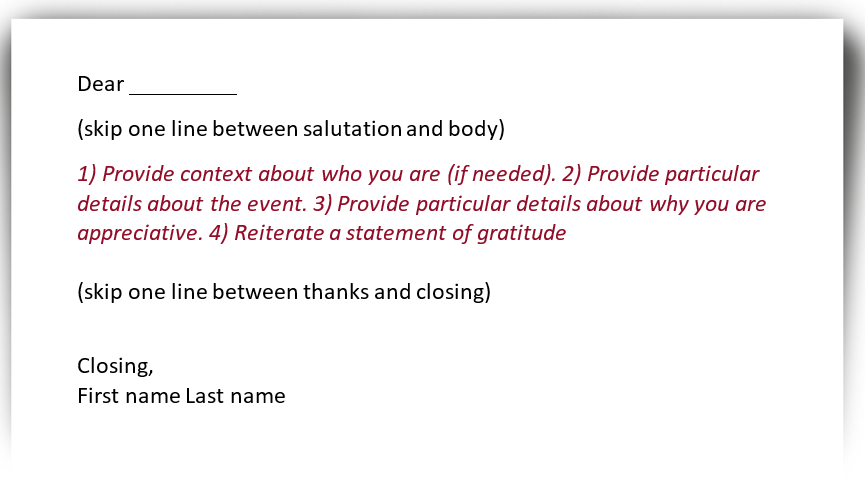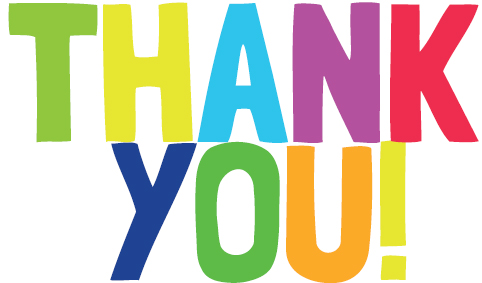Summary
There are a multitude of reasons why we offer thanks to others. Whether someone has done us a favor, given us a gift, shared their personal or professional time, or even just offered a kind word, thanking them with a sincere thank you note is a timeless and appreciated form of gratitude. A timely and genuine thank you note is essential in a range of circumstances, which makes writing one a useful skill to learn. In this lesson, students will write a sincere thank you note to someone they wish to extend gratitude. This lesson includes optional modifications for distance learning. Resources for use in Google Classroom are included.
Essential Question(s)
Why is it important to give thanks?
Snapshot
Engage
Students use www.worditout.com to generate a word cloud of terms pertaining to giving thanks.
Explore
Students brainstorm ideas of who to send a thank you note to and explore the format of a thank you note.
Explain
Students draft a thank you note.
Extend
Students edit and revise their thank you note and examine the benefits of giving thanks.
Evaluate
Students reflect on the process of giving thanks and send their thank you notes.
Materials
Lesson Slides (attached)
Thank You Note Format (attached; one per student)
Materials for physical thank you notes:
Notebook paper
Construction paper
Stationery
Envelopes
Stamps
Internet or Wi-Fi
Access to word cloud generator (like www.worditout.com)
Engage
To begin, open a new Collaborative Word Cloud template using Mentimeter.
Display slides 3-4 and review the lesson’s essential question and learning objective with your students.
Display slide 5 and tell students that you want to hear what words come to mind when they hear the phrase “giving thanks.” Tell students that you will be typing in words in a word cloud generator and want synonyms for the words “thankful” and “gratitude.” Since you shared those last two words, start the word cloud list in worditout.com with the entries “thankful” and “gratitude.” Type in words as they share.
Begin with words that are synonymous with giving thanks like “gratitude” and “thankful.” Sample responses might also include “honored” “grateful” “pleased.” Once it seems like this first round is exhausted, tell students that you would like them to share words that express how they feel when someone does a favor for them or gives them a gift. Ask for a new round of words, using the same worditout.com template. Sample responses might include “excited,” “surprised,” “recognized,” etc. Keep typing in responses for students to see until it seems that the energy is waning and there are enough quality words shared.
After the template is full, press the button to generate the word cloud and look at it as a class. Slide 6 is a placeholder for you to include an image of the word cloud in the lesson slides if you would like.
Explore
Tell students that they will be writing a thank you note and that this word cloud is part of the brainstorming process. With the word cloud image still displayed, ask for a few ideas of why someone would write a thank you note. After hearing responses, display slide 7 and share the additional reasons:
When you receive a favor
When you are given a gift
After an interview
When you have been a guest
Just because!
For these examples, source ideas from the class about specific examples they have experienced when writing a thank you note was appropriate.
Pass out copies of the attached Thank You Note Format handout and read the introduction together.
Ask students to keep their responses to the word cloud in mind while you go over the handout as a class, reflecting on someone that they might want or need to write thank you note for.
Next, ask students, “When is the best time to send a thank you note?” Tell them that timing is important. The best practice is to send a note of thanks as soon as possible. Of course, there are times when we realize gratitude far after we have received kindness or a favor from someone; in these instances, a belated thank you note is still appropriate and appreciated by the recipient.
Direct students’ attention to the “Format” section of the handout and slide 8. Look at the elements of a thank you note together.
Appropriate greeting (formal or casual)
Personal context (if needed)
Particular details about the event
Particular details about why you are appreciative
Reiterate a statement of gratitude
Appropriate closing
For each element, there is a coordinating explanation and example on the second page. As you go through each part of the email, encourage students to take notes and source other examples.
Display slide 9 and review the email together.
Display slide 10 and direct your student’s attention to the bottom of the handout. In this space, instruct your students to begin brainstorming their own thank you note. Now that you have gone over each element of a thank you note on the handout, have them determine who they will write a thank you note to and for what they are thanking the recipient.
Explain
Using the handout as a guide, and slide 11, provide students with time to draft a thank you note.
A hard copy thank you note is a classic medium. Materials can range from simple notebook paper and an envelope to formal stationery. If letters will be mailed, a postage stamp is necessary, as is the recipient’s address. In the event that these materials are unavailable, it is still important to express gratitude. A less formal means of doing this is through email. For ease of sending notes, this lesson recommends writing a note to a teacher at school to whom students are grateful. When letters are complete, they could be hand-delivered to the teachers’ school mailboxes.
Regardless of how the thank you notes will be sent (mailed or emailed), the first draft should be handwritten.
After determining who students will write to, and about what, they will use the format below (and on the handout) as a template.

Extend
Display slide 12 and instruct students to re-read their thank you note draft to look for errors. This is a short note, but remind students that even though this draft is short, it is still a draft, and as such should go through the writing process.
Students have done their brainstorming and composed a rough draft. Now, ask them to re-read their email draft through the eyes of the recipient.
Once students have had time to re-read, edit, and revise their thank you notes, tell them that there is a multitude of benefits to giving thanks. Articles like Forbes’ “7 Scientifically Proven Benefits Of Gratitude That Will Motivate You To Give Thanks Year-Round” describe the personal benefits to both the recipient and sender of gratitude.
Share this article, or one like it, with students to extend their understanding of having an “attitude of gratitude”. Reinforce that sending a thank you note is not just about checking off a box, and that cultivating gratitude has deeper implications.
Evaluate
To close this lesson, display slide 13, and revisit the essential question: “Why is it important to give thanks?”
Pull up the www.worditout.com word cloud image that was generated in the Engage of this lesson. Now that students have composed their thank you notes and looked at some benefits of expressing gratitude, they will do a reflective write based on the original word cloud.
Display slide 14 and instruct students to write a Word Splash on a separate sheet of paper using the word cloud image for inspiration:
Choose 3 words from the word cloud image (for example, “thanks,” “gratitude,” “recognition.”
Use these 3 words in a reflection that answers the question “Why is it important to give thanks?”
Write at least 3 sentences.
Take volunteers to share their answers. These reflections can be turned in separately from the thank you notes.
After the reflection, and as a culminating step to this lesson, the thank you notes will be sent from students to their recipients.
Resources
K20 Center. (n.d.). Collaborative Word Clouds. Strategies. https://learn.k20center.ou.edu/strategy/103
K20 Center. (n.d.). Google Classroom. Tech Tools. https://learn.k20center.ou.edu/tech-tool/628
K20 Center. (n.d.). Mentimeter. Tech Tools. https://learn.k20center.ou.edu/tech-tool/645
K20 Center. (n.d.). Word Splash. Strategies. https://learn.k20center.ou.edu/strategy/199
Morin, A. (2017, November 27). 7 scientifically proven benefits of gratitude that will motivate you to give Thanks year-round. https://www.forbes.com/sites/amymorin/2014/11/23/7-scientifically-proven-benefits-of-gratitude-that-will-motivate-you-to-give-thanks-year-round/?sh=15100fe0183c
Transform your text into word clouds! (n.d.). http://www.worditout.com/


